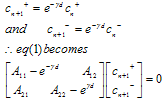-
Paper Information
- Next Paper
- Paper Submission
-
Journal Information
- About This Journal
- Editorial Board
- Current Issue
- Archive
- Author Guidelines
- Contact Us
International Journal of Electromagnetics and Applications
p-ISSN: 2168-5037 e-ISSN: 2168-5045
2012; 2(1): 1-3
doi: 10.5923/j.ijea.20120201.01
An Electromagnetic-Neurophysiological Model of Memory
Kanad Ray
Institute of Engineering and Technology, JK Lakshmipat University, Jaipur, Rajasthan, 302026, India
Correspondence to: Kanad Ray , Institute of Engineering and Technology, JK Lakshmipat University, Jaipur, Rajasthan, 302026, India.
| Email: |  |
Copyright © 2012 Scientific & Academic Publishing. All Rights Reserved.
Three distinct processes of memory have been identified. These are an encoding process, a storage process and a retrieval process. In this paper we are suggesting that this information processing theory can be understood from the application of a neurophysiological- electromagnetic theory of “brainwaves” based on known (but highly idealized) properties of synaptic action and has been formulated with implications for a large scale integration required for cognitive processes.
Keywords: Memory, Brain Waves , Bloch Waves, Transmission Line, Neurophysiological-Electromagnetic Theory
Cite this paper: Kanad Ray , "An Electromagnetic-Neurophysiological Model of Memory", International Journal of Electromagnetics and Applications, Vol. 2 No. 1, 2012, pp. 1-3. doi: 10.5923/j.ijea.20120201.01.
1 Introduction
- Memory of some sort is fundamental to our understanding of behaviour and mind. The ideas and theories in the study of memory have changed drastically in the last 20 years[1-3]. Earlier work took its inspiration from conditioning studies and looked at human memory in terms of associations, or connections, between stimuli and responses. Although this approach to memory resulted in the discovery of numerous important principles, it seemed to many psychologists, inadequate to account for the richness and flexibility of human memory. The current trend in the study of memory is to emphasize cognitive, or mental, processes over stimulas response associations. Three distinct processes of memory have been identified. These are an encoding process, a storage process and a retrieval process. Encoding is the process of receiving sensory input and transferring it into a form, or code, which can be stored; storage is the process of actually putting coded information in to memory; and retrieval is the process of gaining access to stored, coded information when it is needed. In the Atkinson-Shiffrin theory, memory starts with a sensory input from the environment. This input is held for a very brief time -several seconds at most- in a sensory register associated with the sensory channels (vision,, hearing, touch and so forth). Information that is attended to and recognised in the sensory may be passed on to short term memory (STM), where it is held for perhaps 20 or 30 secs. Some of the information reaching STM is processed by being rehearsed – that is by having attention focussed on it, perhaps by being repeated over and over or perhaps by being processed in some other way thatwill link it up with other information already stored in memory. Information that is rehearsed may then be passed along to long term memory (LTM), information not so processed is lost. When items of information are placed in LTM, they are organised in to categories, where they may reside for days, months, years or for a lifetime. When one remembers something, a representation of the item is withdrawn or retrieved from LTM. In this paper we are suggesting that this information processing theory can be understood from the application of a neurophysiological- electromagnetic theory of “brainwaves” based on known (but highly idealized) properties of synaptic action and has been formulated with implications for a large scale integration required for cognitive processes[4-7]. In subsequent papers [8-9] we applied the model to suggest an explanation for the surge of electrical activity during near death experience( NDE) and coordination of complex activity for sensory information processing.It is obvious that some physical change must take place in the nervous system when we learn something new. A theory stated by Donald Hebb (1949) may turn out to be an accurate model of the physiological process responsible for learning and memory. According to Hebb, synaptic facilitation is the biological basis of learning and memory. Individual experiences result in unique patterns of neural activity, which reverberate through neural loops. This causes structural changes in the synapses to occur. These changes make firing in the loop more likely in the future. In other words, synapses become more efficient, or facilitated. Thus for Hebb, changes in the synapses are the biological basis of memory. So when excited above a certain level, the threshold, the neuron fires , that is, it transmits an electrical signal. Synapses are one way connections. Signals pass from axon to dendrite but do not travel in the opposite direction. The signals are received mostly by the dendrites of the next cell[10-13].
2. Method
- Modelling a myelinated axon as a lossy transmission line of infinite periodic structure and regarding as a cascade of identical cells(Fig.1);in previous papers[4-9] we argued that brain waves can be treated as “Bloch waves” which may provide an important mechanism for a large scale integration required between the constantly interacting areas of the brain.
 | Figure 1. Transmission line axon model |
 | (1) |
 | (2) |
 | (3) |
 Abstract
Abstract Reference
Reference Full-Text PDF
Full-Text PDF Full-Text HTML
Full-Text HTML